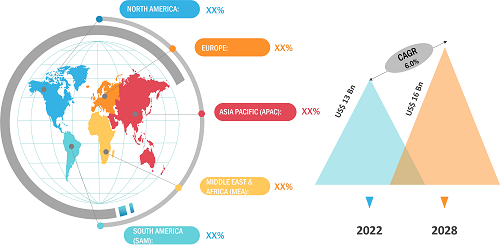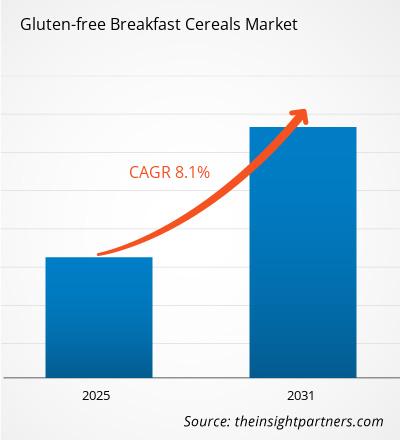グルテンフリーの朝食用シリアル市場は、2022 年の 130 億米ドルから 16 米ドルに成長すると予想されています2031年までに10億ドル。 2022 年から 2031 年にかけて 6% の CAGR で成長すると予想されています。
グルテンフリーの朝食用シリアルは加工穀物から作られており、ビタミンやミネラルが豊富に含まれています。牛乳、ヨーグルト、フルーツ、ナッツと一緒に食べるのが一般的です。グルテンフリーの朝食シリアルは、通常、すぐに食べられる (RTE) 製品またはホットシリアル (HC) として販売されます。グルテンを含む穀物に由来するシリアルには、「グルテンフリー」とラベルを付けることができます。グルテンを除去するために加工されている場合、およびそのシリアルを摂取した結果、食品中のグルテンが 20 ppm 未満になった場合。
市場のダイナミクス
過敏性腸症候群(IBS)とセリアック病の発生率の上昇により、先進国と発展途上国全体でグルテンフリー製品の需要が高まっています。 IBSに苦しむ人はグルテンに敏感であり、グルテンの摂取により問題が悪化します。これらの病気の有病率は、米国、カナダ、ドイツ、フランスなどの北米および欧州の先進国で増加しています。健康的な栄養についての意識が高まることで、シリアルや穀物などの購入や消費に関する情報に基づいた意思決定が促進されます。
市場範囲
市場セグメンテーション
世界のグルテンフリー朝食用シリアル市場は、製品タイプ、カテゴリ、流通チャネルに分割されています。製品タイプに基づいて、市場はホットシリアルとインスタントシリアルに分類されます。カテゴリーごとに、市場はオーガニックと従来型に二分されます。流通チャネルの観点からは、グルテンフリーの朝食用シリアル市場はスーパーマーケットと小売店に分類されます。ハイパーマーケット、コンビニエンス ストア、オンライン小売店など。
世界のグルテンフリー朝食用シリアル市場は、北米、ヨーロッパ、アジア太平洋 (APAC)、中東、および 5 つの主要地域に分割されています。アフリカ (MEA)、および南部およびアフリカ (MEA)中米。このレポートには、18 か国の市場の分析と予測が含まれており、主要地域で普及している現在の傾向と機会も含まれています。
2021 年のグルテンフリー朝食用シリアル市場は北米が独占しましたが、これは地域全体でセリアック病の有病率が上昇していることが原因と考えられます。セリアック病財団によると、300 万人以上のアメリカ人がセリアック病にかかっています。さらに、セリアック病の有病率は1950年以来、原因不明の4倍または5倍に増加しています。
このように、グルテンフリー製品に対する高い需要がグルテンフリー製品の需要を高めています。地域全体で無料の朝食用シリアル市場が成長。
 出典: The Insight Partners分析
出典: The Insight Partners分析
レポートでは、ドライバー、拘束などの要因を分析します。 、グルテンフリーの朝食用シリアル市場に影響を与える機会、および将来の傾向。また、ポーターの 5 つの力による徹底的な分析も提供し、これらの地域の市場に影響を与える要因を明らかにしています。
新型コロナウイルス感染症 (COVID-19) のパンデミックの影響
新型コロナウイルス感染症(COVID-19)のパンデミックは、グルテンフリーの朝食用シリアル市場にさまざまな影響を与えています。ロックダウンの発動により、さまざまな製造活動が一時的に停止され、その結果供給が減少し、グルテンフリーの朝食用シリアル市場に大きな影響を与えました。さらに、渡航制限により原材料の輸送に多くの困難が生じ、世界経済に悪影響を及ぼしました。この危機のさなか、消費者は自分の健康とフィットネスに非常に関心を持つようになり、グルテンフリーの朝食用シリアルの需要が劇的に増加しました。
2021 年、各国政府がロックダウンを含むいくつかの制限の緩和を発表したことにより、市場は成長を遂げました。製造業者はフル稼働で操業を再開し、需要と供給のギャップを克服することができました。グルテンフリーの朝食用シリアルに対する消費者の需要の高まりに応えるために、多くの製造業者が生産能力を拡大しました。
新型コロナウイルス感染症のパンデミック中、実店舗の閉鎖により消費者がオンライン プラットフォーム経由でさまざまな商品を購入することを余儀なくされたため、電子商取引は重要な役割を果たしました。ロックダウン中にこれらのプラットフォームが宅配サービスを提供したため、オンラインストアを通じてグルテンフリーの朝食用シリアルの売上が増加しました。したがって、消費者は引き続きオンライン ポータルを通じてグルテンフリーの朝食用シリアルを購入すると予想され、これが予測期間中の市場の成長をさらに促進すると予想されます。
市場参加者
このレポートは、グルテンフリーの朝食用シリアル市場における主要な有機および無機の成長戦略に光を当てています。さまざまな企業が、製品の発売、製品の承認、特許、イベントなどの有機的な成長戦略に焦点を当てています。市場で見られる無機的な成長戦略活動は、買収、パートナーシップ、コラボレーションです。これらの活動により、企業は事業と顧客ベースの拡大に取り組むようになりました。
レポートには、グルテンフリー朝食用シリアル市場で活動している主要企業のプロフィールと、SWOT分析および市場戦略が含まれています。また、業界の主要企業にも焦点を当て、企業概要、提供されるコンポーネントとサービス、過去 3 年間の財務情報、過去 5 年間の主要な開発を強調しています。
グルテンフリーの朝食用シリアル市場で事業を展開している主要企業数社のリストを以下に示します。
- General Mills Inc.
- ケロッグ社
- ネスレé SA
- ボブズ レッド ミル ナチュラル フーズ
- Nature's Path Foods
- ホームタウン フード カンパニー
- 純粋にエリザベス
- クエーカー オーツ カンパニー
- キノア コーポレーション
- グルテンフリーの草原
Insight Partner の専任の調査分析チームは、高度な統計専門知識を持つ経験豊富な専門家で構成されており、既存の調査にさまざまなカスタマイズ オプションを提供します。
- 過去2年間の分析、基準年、CAGRによる予測(7年間)
- PEST分析とSWOT分析
- 市場規模価値/数量 - 世界、地域、国
- 業界と競争環境
- Excel データセット


- Helicopters Market
- Blood Collection Devices Market
- Ceiling Fans Market
- Photo Editing Software Market
- Ceramic Injection Molding Market
- Skin Graft Market
- Cosmetic Bioactive Ingredients Market
- Semiconductor Metrology and Inspection Market
- Space Situational Awareness (SSA) Market
- Terahertz Technology Market

Report Coverage
Revenue forecast, Company Analysis, Industry landscape, Growth factors, and Trends

Segment Covered
This text is related
to segments covered.

Regional Scope
North America, Europe, Asia Pacific, Middle East & Africa, South & Central America

Country Scope
This text is related
to country scope.
よくある質問
Some of the customization options available based on request are additional 3-5 company profiles and country-specific analysis of 3-5 countries of your choice. Customizations are to be requested/discussed before making final order confirmation, as our team would review the same and check the feasibility.
The report can be delivered in PDF/PPT format; we can also share excel dataset based on the request.
Key companies in this market are- General Mills Inc., Kellogg's Company, Nestlé SA, Bob’s Red Mill Natural Foods, Nature's Path Foods, Hometown Food Company, purely Elizabeth, The Quaker Oats Company, Quinoa Corporation, Gluten-Free Prairie,
The market is expected to register a CAGR of 8.1% during 2023-2031.
Future trends include the rise of high-protein, low-sugar, and functional gluten-free cereals, along with growing demand for organic and non-GMO options.
The gluten-free breakfast cereals market is driven by rising rates of gluten sensitivity and increasing consumer awareness of gluten-free diets.
Trends and growth analysis reports related to Food and Beverages : READ MORE..
The List of Companies
- General Mills Inc.
- Kellogg's Company
- Nestlé SA
- Bob’s Red Mill Natural Foods
- Nature's Path Foods
- Hometown Food Company
- purely Elizabeth
- The Quaker Oats Company
- Quinoa Corporation
- Gluten-Free Prairie
The Insight Partners performs research in 4 major stages: Data Collection & Secondary Research, Primary Research, Data Analysis and Data Triangulation & Final Review.
- Data Collection and Secondary Research:
As a market research and consulting firm operating from a decade, we have published and advised several client across the globe. First step for any study will start with an assessment of currently available data and insights from existing reports. Further, historical and current market information is collected from Investor Presentations, Annual Reports, SEC Filings, etc., and other information related to company’s performance and market positioning are gathered from Paid Databases (Factiva, Hoovers, and Reuters) and various other publications available in public domain.
Several associations trade associates, technical forums, institutes, societies and organization are accessed to gain technical as well as market related insights through their publications such as research papers, blogs and press releases related to the studies are referred to get cues about the market. Further, white papers, journals, magazines, and other news articles published in last 3 years are scrutinized and analyzed to understand the current market trends.
- Primary Research:
The primarily interview analysis comprise of data obtained from industry participants interview and answers to survey questions gathered by in-house primary team.
For primary research, interviews are conducted with industry experts/CEOs/Marketing Managers/VPs/Subject Matter Experts from both demand and supply side to get a 360-degree view of the market. The primary team conducts several interviews based on the complexity of the markets to understand the various market trends and dynamics which makes research more credible and precise.
A typical research interview fulfils the following functions:
- Provides first-hand information on the market size, market trends, growth trends, competitive landscape, and outlook
- Validates and strengthens in-house secondary research findings
- Develops the analysis team’s expertise and market understanding
Primary research involves email interactions and telephone interviews for each market, category, segment, and sub-segment across geographies. The participants who typically take part in such a process include, but are not limited to:
- Industry participants: VPs, business development managers, market intelligence managers and national sales managers
- Outside experts: Valuation experts, research analysts and key opinion leaders specializing in the electronics and semiconductor industry.
Below is the breakup of our primary respondents by company, designation, and region:

Once we receive the confirmation from primary research sources or primary respondents, we finalize the base year market estimation and forecast the data as per the macroeconomic and microeconomic factors assessed during data collection.
- Data Analysis:
Once data is validated through both secondary as well as primary respondents, we finalize the market estimations by hypothesis formulation and factor analysis at regional and country level.
- Macro-Economic Factor Analysis:
We analyse macroeconomic indicators such the gross domestic product (GDP), increase in the demand for goods and services across industries, technological advancement, regional economic growth, governmental policies, the influence of COVID-19, PEST analysis, and other aspects. This analysis aids in setting benchmarks for various nations/regions and approximating market splits. Additionally, the general trend of the aforementioned components aid in determining the market's development possibilities.
- Country Level Data:
Various factors that are especially aligned to the country are taken into account to determine the market size for a certain area and country, including the presence of vendors, such as headquarters and offices, the country's GDP, demand patterns, and industry growth. To comprehend the market dynamics for the nation, a number of growth variables, inhibitors, application areas, and current market trends are researched. The aforementioned elements aid in determining the country's overall market's growth potential.
- Company Profile:
The “Table of Contents” is formulated by listing and analyzing more than 25 - 30 companies operating in the market ecosystem across geographies. However, we profile only 10 companies as a standard practice in our syndicate reports. These 10 companies comprise leading, emerging, and regional players. Nonetheless, our analysis is not restricted to the 10 listed companies, we also analyze other companies present in the market to develop a holistic view and understand the prevailing trends. The “Company Profiles” section in the report covers key facts, business description, products & services, financial information, SWOT analysis, and key developments. The financial information presented is extracted from the annual reports and official documents of the publicly listed companies. Upon collecting the information for the sections of respective companies, we verify them via various primary sources and then compile the data in respective company profiles. The company level information helps us in deriving the base number as well as in forecasting the market size.
- Developing Base Number:
Aggregation of sales statistics (2020-2022) and macro-economic factor, and other secondary and primary research insights are utilized to arrive at base number and related market shares for 2022. The data gaps are identified in this step and relevant market data is analyzed, collected from paid primary interviews or databases. On finalizing the base year market size, forecasts are developed on the basis of macro-economic, industry and market growth factors and company level analysis.
- Data Triangulation and Final Review:
The market findings and base year market size calculations are validated from supply as well as demand side. Demand side validations are based on macro-economic factor analysis and benchmarks for respective regions and countries. In case of supply side validations, revenues of major companies are estimated (in case not available) based on industry benchmark, approximate number of employees, product portfolio, and primary interviews revenues are gathered. Further revenue from target product/service segment is assessed to avoid overshooting of market statistics. In case of heavy deviations between supply and demand side values, all thes steps are repeated to achieve synchronization.
We follow an iterative model, wherein we share our research findings with Subject Matter Experts (SME’s) and Key Opinion Leaders (KOLs) until consensus view of the market is not formulated – this model negates any drastic deviation in the opinions of experts. Only validated and universally acceptable research findings are quoted in our reports.
We have important check points that we use to validate our research findings – which we call – data triangulation, where we validate the information, we generate from secondary sources with primary interviews and then we re-validate with our internal data bases and Subject matter experts. This comprehensive model enables us to deliver high quality, reliable data in shortest possible time.

 このレポートの無料サンプルを入手する
このレポートの無料サンプルを入手する